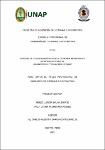| dc.contributor.advisor | García Cortegano, Carlos Alberto | |
| dc.contributor.author | Shuña Zárate, Renzo Junior | |
| dc.contributor.author | Flores Rodríguez, Willy Javier | |
| dc.date.accessioned | 2025-06-19T16:29:03Z | |
| dc.date.available | 2025-06-19T16:29:03Z | |
| dc.date.issued | 2025 | |
| dc.identifier.other | X | |
| dc.identifier.uri | https://hdl.handle.net/20.500.12737/11481 | |
| dc.description.abstract | The objective of this research is to develop and validate a classification system based on artificial neural networks (ANN) for the early diagnosis of dengue, evaluating its performance using key indicators such as accuracy, sensitivity and specificity. The methodological approach is mixed, with a non-experimental predictive design, using clinical data from 10,000 patients from Bucaramanga and validating the system with an external sample of 30 patients from the Regional Hospital of Loreto. The system was implemented with advanced machine learning techniques, adjusting hyperparameters and evaluating its effectiveness through internal and external validations. The results show that the developed model achieved an accuracy of 98.2% in internal validation and 97.5% in external validation, with consistent levels of sensitivity (95.9% 96.8%) and specificity (97.5%-98.1%). Furthermore, the system's ability to classify dengue cases was assessed as "Excellent" according to the predefined quality ranges, highlighting its suitability for clinical settings. The study concludes that this classifier system is a reliable, efficient and applicable tool in real scenarios, improving the early detection of dengue and optimizing the allocation of medical resources. Its generalization capacity, validated with external data, highlights its robustness and potential impact on public health. Finally, this work lays the foundation for the implementation of similar models in the diagnosis of other infectious diseases. | en_US |
| dc.description.abstract | El objetivo de esta investigación es desarrollar y validar un sistema clasificador basado en redes neuronales artificiales (ANN) para el diagnóstico temprano del dengue, evaluando su desempeño mediante indicadores clave como precisión, sensibilidad y especificidad. El enfoque metodológico es mixto, con un diseño no experimental de tipo predictivo, utilizando datos clínicos de 10,000 pacientes de Bucaramanga y validando el sistema con una muestra externa de 30 pacientes del Hospital Regional de Loreto. El sistema fue implementado con técnicas avanzadas de machine learning, ajustando hiperparámetros y evaluando su efectividad mediante validaciones internas y externas. Los resultados muestran que el modelo desarrollado alcanzó una precisión del 98.2% en validación interna y del 97.5% en validación externa, con niveles consistentes de sensibilidad (95.9%-96.8%) y especificidad (97.5%-98.1%). Además, la capacidad del sistema para clasificar casos de dengue fue evaluada como "Excelente" según los rangos de calidad predefinidos, destacando su idoneidad para entornos clínicos. El estudio concluye que este sistema clasificador es una herramienta confiable, eficiente y aplicable en escenarios reales, mejorando la detección temprana del dengue y optimizando la asignación de recursos médicos. Su capacidad de generalización, validada con datos externos, resalta su robustez y potencial impacto en la salud pública. Finalmente, este trabajo sienta las bases para la implementación de modelos similares en el diagnóstico de otras enfermedades infecciosas. | es_PE |
| dc.format | application/pdf | es_PE |
| dc.language.iso | spa | es_PE |
| dc.publisher | Universidad Nacional de la Amazonía Peruana | es_PE |
| dc.rights | info:eu-repo/semantics/openAccess | * |
| dc.rights.uri | https://creativecommons.org/licenses/by/4.0/ | * |
| dc.subject | X | es_PE |
| dc.subject | X | es_PE |
| dc.subject | X | es_PE |
| dc.subject | X | es_PE |
| dc.title | Sistema de clasificación basado en redes neuronales artificiales para el diagnóstico precoz del dengue | es_PE |
| dc.type | info:eu-repo/semantics/bachelorThesis | es_PE |
| thesis.degree.discipline | Ingeniería de Sistemas e Informática | es_PE |
| thesis.degree.grantor | Universidad Nacional de la Amazonía Peruana. Facultad de Ingeniería de Sistemas e Informática | es_PE |
| thesis.degree.name | Ingeniero(a) de Sistemas e Informática | es_PE |
| dc.subject.ocde | https://purl.org/pe-repo/ocde/ford#2.02.04 | es_PE |
| renati.author.dni | 47640859 | |
| renati.author.dni | 48570310 | |
| renati.advisor.orcid | https://orcid.org/0000-0003-3353-9566 | |
| renati.advisor.dni | 05342316 | |
| renati.type | https://purl.org/pe-repo/renati/type#tesis | es_PE |
| renati.discipline | 612156 | es_PE |
| renati.level | https://purl.org/pe-repo/renati/level#tituloProfesional | es_PE |
| renati.juror | Reategui Pezo, Alejandro | |
| renati.juror | Melchor Infantes, Ronald Percy | |
| renati.juror | Torres Monzon, Rony | |
| dc.publisher.country | PE | es_PE |





